Zürich
Switzerland
Introduction
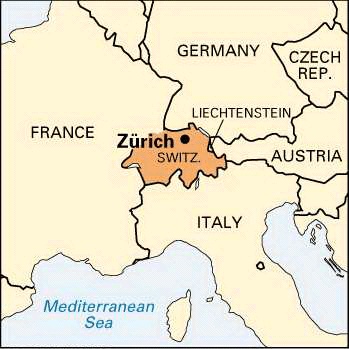
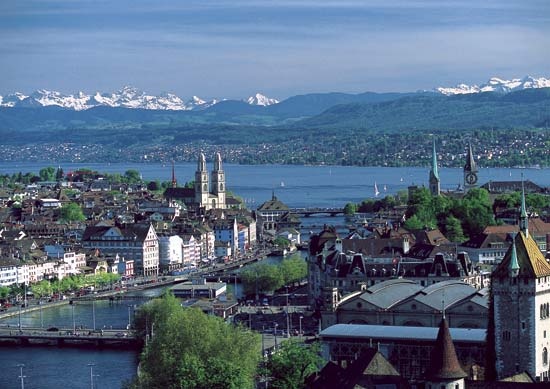 largest city of Switzerland and capital of the canton of Zürich. Located in an Alpine setting at the northwestern end of Lake Zürich (Zürich, Lake), this financial, cultural, and industrial centre stretches out between two forested chains of hills, about 40 miles (60 km) from the northern foothills of the Alps. Two rivers, the Limmat and Sihl, run through the city. Zürich's western and northeastern limitations are formed by the Albis mountains (which include the 2,850-foot 【870-metre】 Üetliberg, considered the “top” of Zürich, with an idyllic view of the lake, mountains, and city) and by Zürichberg, a wooded hilly area. Area city, 34 square miles (88 square km). Pop. (2006 est.) 347,517.
largest city of Switzerland and capital of the canton of Zürich. Located in an Alpine setting at the northwestern end of Lake Zürich (Zürich, Lake), this financial, cultural, and industrial centre stretches out between two forested chains of hills, about 40 miles (60 km) from the northern foothills of the Alps. Two rivers, the Limmat and Sihl, run through the city. Zürich's western and northeastern limitations are formed by the Albis mountains (which include the 2,850-foot 【870-metre】 Üetliberg, considered the “top” of Zürich, with an idyllic view of the lake, mountains, and city) and by Zürichberg, a wooded hilly area. Area city, 34 square miles (88 square km). Pop. (2006 est.) 347,517.History
The first inhabitants of the region were the prehistoric peoples whose hut dwellings rose from pile foundations driven into the shores of the lake. The Celtic Helvetii founded a community on the right bank of the Limmat River; when the Romans conquered this area about 58 BCE, they made the settlement, which they called Turicum, a customs post. Under Roman rule, Zürich grew into a small army stronghold with an adjacent vicus, or Roman village. After the collapse of Rome, the community fell first to the Alemanni, a Germanic people from the north, and later to the Franks, who made it a royal residence.
The community began to flourish as traders settled in the town and took advantage of its position straddling European trade routes. In 1218 Zürich became an imperial free city, and in 1351 it joined the Swiss Confederation, a coalition of cantons that were opposed to the Austrian Habsburgs (Habsburg, House of). In 1336 the citizens accepted a constitution that, based democratically on the guild system, balanced the power of the various crafts, the trades, and the nobility. As the guilds became more powerful, the city was able to purchase its freedom from the emperor in 1400, and tax obligations were lifted. Zürich became embroiled in conflicts with neighbouring territories, but economic growth continued relatively unimpeded. Staging repeated successful forays into the surrounding countryside, the city began controlling an even larger part of it; moreover, Zürich profited from being conveniently located on both the southbound trade route, centred on the St. Gotthard Pass, and the east-west route from the Rhône River to the Danube (Danube River).
In 1519 Huldrych Zwingli (Zwingli, Huldrych), a priest at the Grossmünster (“Great Minster”), began to preach a series of sermons that initiated the Swiss Protestant Reformation and transformed the character of Zürich itself. It turned into an industrious puritanical city maintaining lively business relations and an exchange of ideas with other Protestant cities, notably Bern and Geneva. During the Counter-Reformation, the city offered asylum to many refugees from northern Italy and France, and the new residents further stimulated cultural and economic growth.
Napoleon (Napoleon I)'s occupation of Switzerland in 1798 ended the old political order, and Zürich was reorganized under the Helvetic Republic, which tried to form a unitary Swiss state. Zürich residents did not like the centralized control imposed by the new republic, and years of conflict between the city, the surrounding countryside, and the other cantons ensued. The disputes ended in 1803 when Napoleon mediated, and the canton of Zürich, dominated by the city, became a sovereign member of a new Swiss Confederation. The political rule exerted by the aristocratic ancien régime was replaced by a liberal democratic order by 1816.
The 1830 July Revolution in Paris sparked similar revolutions in Swiss cantons, including Zürich canton, which gave way to liberal reform. The cantons' citizenry was able to elect and exercise strong control over the legislature (Gemeinderat) as well as the executive branch of government (Stadtrat). A new canton constitution was drafted in 1831. Under the Swiss constitution of 1848, the autonomous cantons became federal states, each with its own constitution. The people of Zürich adopted a new constitution in 1869, which included mandatory referendums, direct election of cantonal government by the citizens, and limits on presidential terms. This democratic constitution served as a model for other Swiss cities and influenced the revision of Switzerland's national constitution in 1874.
Zürich thus became well equipped to enter the modern industrial era. As early as 1787, about one-fourth of the population was engaged in textile manufacturing (a successor to the medieval silk industry, which lost its importance after French occupation). Agriculture and textile production were gradually replaced with small-scale industry, and local factories focused on producing specialized goods. All of these changes helped aid an economic expansion centred on manufacturing and service industries. Zürich's historic international links also placed it in the forefront of modern world finance.
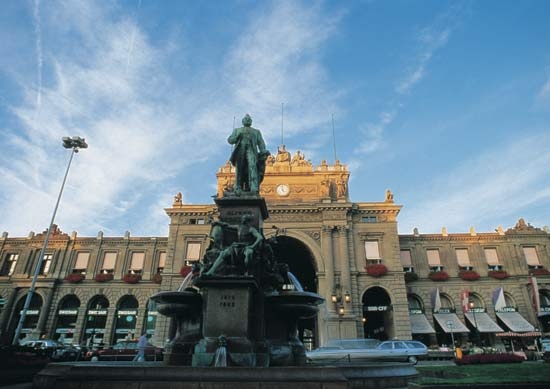 Improved transport played an important role in the 19th century. Among Switzerland's first railway lines was the one linking Zürich with the neighbouring city of Baden; opened in 1847, it was nicknamed the “Spanish Roll Railway” because the bread rolls it brought from Baden were reputedly still warm on arrival. In 1882 the Zürich-Milan trans-Alpine railway line opened, its existence made possible by the construction of the 10-mile (16.3-km) St. Gotthard Tunnel, designed by industrial and railway pioneer Alfred Escher (Escher, Alfred).
Improved transport played an important role in the 19th century. Among Switzerland's first railway lines was the one linking Zürich with the neighbouring city of Baden; opened in 1847, it was nicknamed the “Spanish Roll Railway” because the bread rolls it brought from Baden were reputedly still warm on arrival. In 1882 the Zürich-Milan trans-Alpine railway line opened, its existence made possible by the construction of the 10-mile (16.3-km) St. Gotthard Tunnel, designed by industrial and railway pioneer Alfred Escher (Escher, Alfred).In the mid-19th century the University of Zürich (1833), maintained by the canton, and the Swiss Federal Institute of Technology (1855) were founded. The University of Zürich was the first university in Europe to accept female students. Zürich also boasts a long line of Nobel Prize winners among its citizenry, particularly in the fields of physics (Wilhelm Konrad Röntgen (Röntgen, Wilhelm Conrad), 1901; Albert Einstein (Einstein, Albert), 1921; and Wolfgang Pauli (Pauli, Wolfgang), 1945), chemistry (Richard Ernst (Ernst, Richard R.), 1991), and medicine (Rolf Zinkernagel (Zinkernagel, Rolf M.), 1996). Noted Zürich-born authors include Gottfried Keller (Keller, Gottfried), Conrad Ferdinand Meyer (Meyer, Conrad Ferdinand), and Max Frisch (Frisch, Max).
The financial services sector developed in response to the growing demand for capital by the evolving industries and the railways. In 1856 Escher founded the Schweizerische Kreditanstalt, a banking institute wholly geared to financing industrial and commercial projects. By the end of the 19th century, Zürich had become Switzerland's financial and economic centre. Before that time, Zürich's banks had been in the shadow of those of Basel and Geneva.
Switzerland was neutral during World War I, and Zürich gave asylum to intellectuals including James Joyce (Joyce, James) and Vladimir Ilich Lenin (Lenin, Vladimir Ilich). In reaction to the horrors of the war, the Dada art movement emerged in Zürich at the Cabaret Voltaire, a small tavern established in 1916 by Hugo Ball (Ball, Hugo) on Spiegelgasse.
During World War II, Zürich banks took advantage of banking secrecy laws to help the Nazi Party launder gold and stolen valuables. It was not until the 1990s that the banks' role during the war was made public. In 1998 the two largest Swiss banks, Credit Suisse Group and UBS AG, agreed to pay two billion Swiss francs to international Jewish organizations.
After World War II, Zürich's airport became the primary international airport of Switzerland. This helped the city to further strengthen its economic position in the country. By the second half of the 20th century, the textile industry had completely lost its importance, and the production of machines had become dominant. At the same time, the service sector, notably banks and insurance companies, gained in importance. Further developments that bolstered the financial sector in Zürich were the decision of the National Bank of Switzerland, which has headquarters in Zürich and Bern, to install its board of directors in Zürich, the introduction of absolute confidentiality in banking, and the temporary closure of the London Gold Exchange in 1968. The Zürich banks reacted at once and founded the Zürich Gold Pool, a gold trading organization set up by Switzerland's largest banks, which helped establish Zürich as one of the most important trading places for gold worldwide.
The postwar period brought an influx of immigrants both from rural Switzerland and from abroad, pushing the population past the city's administrative boundaries and into the hinterland. For the first time, the city and surrounding area reached a population of one million.
Zürich struggled with problems of extensive illicit drug use throughout the 1980s and early '90s. Indeed, Platzspitz, a public park behind the main railway station, became infamously known as “Needle Park.” After the park closed in 1992, more-liberal policies were implemented, but programs such as the one that supplied addicts with heroin substitutes such as methadone were only relatively successful in addressing the problem. Although the number of drug users has not decreased much since then, street crime and violence related to drug problems have improved considerably.
The beginning of the 21st century was a difficult time for the city, whose finance-oriented economy was shaken by crises in the world financial markets in the wake of corporate collapses and the spiraling stock market in the United States. In 2001 Zürich-based Swiss Air Transport Company Ltd. (Swissair) collapsed as a result of both an aggressive business expansion strategy and the airline crisis following the September 11 attacks in the United States. In 2002, however, elements of the former airline reemerged as Swiss International Air Lines (SWISS), which, after a difficult start, grew rapidly. Similarly, the recovery of the financial markets in the following years brought a period of prosperity to the city in general, securing Zürich's position as the uncontested economic capital of Switzerland. Moreover, Switzerland's resistance to joining the European Union (EU) had not hindered Zürich's economic development, as bilateral agreements with the EU gave Switzerland full access to EU markets.
Since the 1990s Zürich has been governed by a centre-left coalition of parties, which has undertaken efforts to create sustainable development even as it continued to position the city as the economic centre of Switzerland. Together with the Swiss Federal Institute of Technology and the University of Zürich—both leading universities in environmental sciences—the city pursues ambitious energy, environmental, and spatial development policies.
The contemporary city
 Zürich is at the core of a constantly expanding metropolitan area that encompasses parts of central, northern, and eastern Switzerland. It is the industrial, financial, and cultural centre of the country and one of the most cosmopolitan and dynamic Swiss cities. Throughout the city centre, green space extends to the shores of Lake Zürich, which are lined by attractive public parks, and up to the slopes of Zürichberg.
Zürich is at the core of a constantly expanding metropolitan area that encompasses parts of central, northern, and eastern Switzerland. It is the industrial, financial, and cultural centre of the country and one of the most cosmopolitan and dynamic Swiss cities. Throughout the city centre, green space extends to the shores of Lake Zürich, which are lined by attractive public parks, and up to the slopes of Zürichberg.The city has a diverse ethnic composition; more than one-third of its population is made up of immigrants. The largest immigrant groups are from Italy, the Balkans, Portugal, and Germany. There is also a small population of non-European immigrants. The integration of immigrants, particularly those displaced by conflict in the Balkans and those from non-European countries, posed a series of problems, especially for schools, at the end of the 20th century and beginning of the 21st. The resulting ethnic tensions eased, however, with the city's introduction of social programs targeted at immigrants and as tighter restrictions were instituted for immigration from outside the EU.
Zürich was once a Protestant stronghold, but by the early 21st century only about one-third of Zürich's inhabitants were Protestant. Roman Catholicism became the dominant religion, mainly due to immigration. Immigrants from the Balkans and Turkey have contributed to a growing Muslim community. There is also a small Jewish community in Zürich.
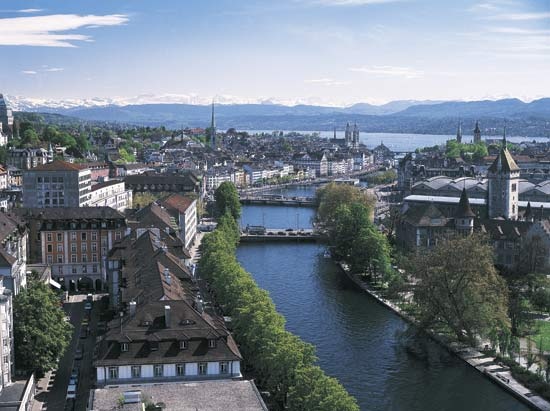
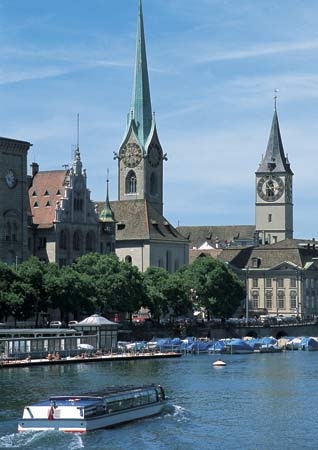 Zürich's city centre and most of the city's architectural features extend along both shores of the Limmat River, which runs from the north side of Lake Zürich through the city centre and out to the west. Zürich's lively and well-preserved Altstadt (Old Town), part of the city centre, boasts an architectural legacy including the Romanesque Grossmünster, built by Charlemagne in the 700s; the 13th-century St. Peter's Church; and elegant guild houses and patrician residences, some of which are used as restaurants or for civic functions. The Fraumünster (Minster of Our Lady) is noted for its stained glass windows designed by Marc Chagall (Chagall, Marc).
Zürich's city centre and most of the city's architectural features extend along both shores of the Limmat River, which runs from the north side of Lake Zürich through the city centre and out to the west. Zürich's lively and well-preserved Altstadt (Old Town), part of the city centre, boasts an architectural legacy including the Romanesque Grossmünster, built by Charlemagne in the 700s; the 13th-century St. Peter's Church; and elegant guild houses and patrician residences, some of which are used as restaurants or for civic functions. The Fraumünster (Minster of Our Lady) is noted for its stained glass windows designed by Marc Chagall (Chagall, Marc).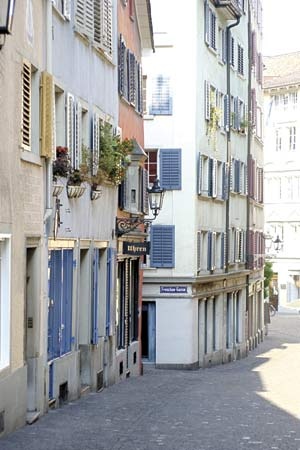 Adjacent to the historic Altstadt is the Bahnhofstrasse shopping district, whose distinguished architecture dates back to 1870. Centred on Paradeplatz, Bahnhofstrasse is home to luxury shops, including those of the country's renowned jewelers and watchmakers. Cafés, department stores, and shops selling local handicrafts and books also line the boulevard. Just across the Limmat River from the Bahnhofstrasse lies Zürich's youth-oriented Niederdorfstrasse, which features bistros, shops, and ethnic restaurants.
Adjacent to the historic Altstadt is the Bahnhofstrasse shopping district, whose distinguished architecture dates back to 1870. Centred on Paradeplatz, Bahnhofstrasse is home to luxury shops, including those of the country's renowned jewelers and watchmakers. Cafés, department stores, and shops selling local handicrafts and books also line the boulevard. Just across the Limmat River from the Bahnhofstrasse lies Zürich's youth-oriented Niederdorfstrasse, which features bistros, shops, and ethnic restaurants.Zürich's middle- and lower-class neighbourhoods are in the western and northern parts of the city. To the north of Zürichberg, between the airport and the city, is the Glattal, one of the most rapidly growing areas in Switzerland. In Zürich Nord, a district in the north of the city near the airport, a minor downtown area has gradually formed. A large number of firms, particularly the headquarters of international companies, have located there. Zürich West, a former industrial and red-light district, has been transformed into a popular area with ambitious contemporary architecture, theatres, shops, art galleries, residential living spaces, and lots of nightlife.
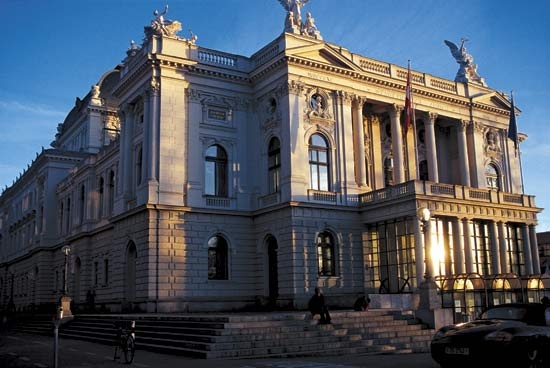 Zürich has nurtured a rich cultural life, and its theatres and opera have often been characterized by innovation and experiment. The Zürich Opera House (1891), the Schauspielhaus (Theatre; 1901), and the Schiffbau (Shipping Hall; 2001) have international prominence. Zürich has its own orchestra, the Tonhalle, which has its own hall, where the Zürich Chamber Orchestra also plays. Cabaret Voltaire reopened in 2004 in the Altstadt, reviving Zürich's tradition of avant-garde performance.
Zürich has nurtured a rich cultural life, and its theatres and opera have often been characterized by innovation and experiment. The Zürich Opera House (1891), the Schauspielhaus (Theatre; 1901), and the Schiffbau (Shipping Hall; 2001) have international prominence. Zürich has its own orchestra, the Tonhalle, which has its own hall, where the Zürich Chamber Orchestra also plays. Cabaret Voltaire reopened in 2004 in the Altstadt, reviving Zürich's tradition of avant-garde performance.Starting in the 2000s more art galleries opened throughout Zürich, and Raemistrasse, just east of the city centre, became known as the city's “art mile.” Notable museums include the Swiss National Museum (1898), which has a treasure trove of historical, artistic, and scientific collections, and the Museum of Fine Arts, whose broad collection includes Swiss and modern paintings.

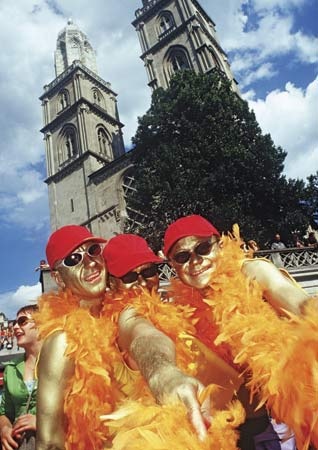 The city has traditional annual festivals: the Sechseläuten in April, with a guild procession and the ceremonial burning of a snowman, and the Knabenschiessen in September, a sharpshooting contest for young people. Along with these traditional festivals, there is the Zürich Carnival (Fasnacht) in late winter and the Street Parade in August, which began in the 1990s and draws thousands of people to dance to techno music.
The city has traditional annual festivals: the Sechseläuten in April, with a guild procession and the ceremonial burning of a snowman, and the Knabenschiessen in September, a sharpshooting contest for young people. Along with these traditional festivals, there is the Zürich Carnival (Fasnacht) in late winter and the Street Parade in August, which began in the 1990s and draws thousands of people to dance to techno music.The city also has two top-division football (soccer) teams, Grasshoper-Club Zürich and Zürich F.C. A new football stadium, Letzigrund, was constructed in 2007. Mountain climbing is also a popular sport for the people of Zürich.
The city has built new hotels, renovated museums and theatres, and illuminated landmarks in its attempt to become a premier tourist destination. At the same time, “Science City,” an international think-tank campus constructed by the Swiss Federal Institute of Technology, has contributed to Zürich's stature as an important centre for innovative research and education. Long prominent in banking and business, Zürich has been energized by its emerging art scene, newly popular neighbourhoods, and an influx of immigrants that have contributed to its revived youthfulness and diversity. Zürich has become one of the most vibrant cities in 21st-century Europe.
canton, Switzerland
 canton, northeastern Switzerland, with an area of 668 sq mi (1,729 sq km), of which about 80 percent is reckoned as productive, including about 195 sq mi of forests. Of the rest, 28 sq mi are occupied by lakes, chiefly Greifen and Pfäffikon and part of Lake Zürich. The terrain consists of shallow river valleys draining northward toward the Rhine and separated by ridges trending northwest to southeast. The most important valley is that of the Linth, which expands into Lake Zürich (Zürich, Lake) and is continued as the Limmat. East of the lake, separated by successively higher ridges, are the valleys of the Glatt, which flows through the lake called Greifensee, and the more gorgelike Töss, separated from the Toggenburg (valley) by a ridge along the east boundary that reaches 3,717 ft (1,133 m) at the Hörnli. West of the lake is the valley of the Sihl, bounded farther west by the Albis Range, with Albishorn (3,002 ft) as its highest point.
canton, northeastern Switzerland, with an area of 668 sq mi (1,729 sq km), of which about 80 percent is reckoned as productive, including about 195 sq mi of forests. Of the rest, 28 sq mi are occupied by lakes, chiefly Greifen and Pfäffikon and part of Lake Zürich. The terrain consists of shallow river valleys draining northward toward the Rhine and separated by ridges trending northwest to southeast. The most important valley is that of the Linth, which expands into Lake Zürich (Zürich, Lake) and is continued as the Limmat. East of the lake, separated by successively higher ridges, are the valleys of the Glatt, which flows through the lake called Greifensee, and the more gorgelike Töss, separated from the Toggenburg (valley) by a ridge along the east boundary that reaches 3,717 ft (1,133 m) at the Hörnli. West of the lake is the valley of the Sihl, bounded farther west by the Albis Range, with Albishorn (3,002 ft) as its highest point.Historically, the canton represents the territories acquired up to 1803 by its capital, Zürich, which officially ranks as the first to join the Swiss Confederation in 1351. The whole of the lower part of Lake Zürich was added in 1362, and the canton reached the Rhine after the purchase of Winterthur from the Habsburgs in 1467. It now extends from its enclave on the right bank of the Rhine in the German state of Baden-Württemberg to about 8 mi (13 km) south of the Pfäffikon See. The present cantonal constitution dates from 1869.
Although the land is highly cultivated, the canton is essentially a manufacturing area, noted especially for machinery and railway rolling stock; about one-third of the nation's total machine production is situated in the canton. Silk and cotton weaving are widespread. Zürich and Winterthur are the principal centres, while Uster, east of the Greifensee, and Thalwil, Horgen, and Wädenswil, on the western shore of Lake Zürich, are all industrial towns. Railways run through the valleys, and standard lines and mountain railways radiate in all directions from the city of Zürich. The Limmat Valley (Zürich to Baden) carried the first railway line opened (1847) in Switzerland. The population, the largest of any Swiss canton, is German speaking and predominantly Protestant. Pop. (2007 est.) 1,284,052.
- guilder
- Guildford
- Guildhall
- Guild Socialism
- Guilford
- Guilford College
- Guilford Courthouse, Battle of
- Guilford, Joy Paul
- Guilin
- Guillaume Amontons
- Guillaume Apollinaire
- Guillaume, Baron Dupuytren
- Guillaume-Benjamin-Amand Duchenne
- Guillaume Briçonnet
- Guillaume Brune
- Guillaume Budé
- Guillaume, Charles Édouard
- Guillaume Coustou
- Guillaume de Baillou
- Guillaume Delisle
- Guillaume de Lorris
- Guillaume de Machaut
- Guillaume de Nogaret
- Guillaume de Salluste Bartas, seigneur du
- Guillaume de Salluste, seigneur du Bartas